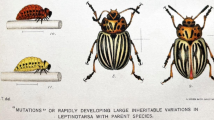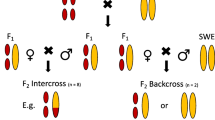Summary
The effect of multiple mating on the average genetic relatedness within socially interacting sib groups was studied in the imported willow leaf beetle. Using an electrophoretically determined genetic marker, it was demonstrated that between 49 and 96% of wild caught females produce egg clutches expressing multiple sires. Following theoretical predictions of Wade (1982), this information was used to estimate the harmonic mean number of sires per family and then the average relatedness within families. Average relatedness was estimated to be 0.38. An alternate form of data analysis suggested by Pamilo and Crozier (1982) did not require any knowledge of paternity and resulted in a slightly higher estimate of relatedness, 0.44.
Similar content being viewed by others
References
Birdsall OA, Nash D (1973) Occurrence of successful multiple insemination of females in natural populations of deer mice (Peromyscus maniculatus), Evolution 27:106–110
Hamilton WD (1964) The genetical evolution of social behavior, II. J Theor Biol 7:17–52
Hanken J, Sherman PW (1981) Multiple paternity in Belding's ground squirrel litters. Science 212:351–353
Hoogland JL, Foltz DW (1982) Variance in male and female reproductive success in a harem-polygynous mammal, the black-tailed prairie dog (Sciuridae: Cynomys ludovicianus). Behav Ecol Sociobiol 11:155–163
Lester RJ, Selander RK, (1981) Genetic relatedness and the social organization of Polistes. Am Nat 117:147–166
McCracken GF, Bradbury JW (1981) Social organization and kinship in the polygynous bat Phyllostomus hastatus. Behav Ecol Sociobiol 8:11–34
Merritt RB, Wu BJ (1975) On the quantification of promiscuity (or “Promyscus” maniculatus). Evolution 29:575–578
Metcalf RA, Whitt GS (1977) Intra-nest relatedness in the social wasp Polistes metricus. A genetic analysis. Behav Ecol Sociobiol 2:339–351
Murray J (1964) Multiple mating and effective population size in Cepaea nemoralis. Evolution 18:283–291
Page RE, Metcalf RA (1982) Multiple mating, sperm utilization, and social evolution. Am Nat 119:263–281
Pamilo P (1982) Multiple mating in Formica ants. Hereditas 97:37–45
Pamilo P (1984) Genotypic correlation and regression in social groups: multiple alleles, multiple loci and subdivided populations. Genetics 107:307–320
Pamilo P, Crozier RH (1982) Measuring genetic relatedness in natural populations: methodology. Theor Popul Biol 21:171–193
Raupp MJ (1982) Spatial distribution and seasonal abundance of the Imported Willow Leaf Beetle, Plagiodera versicolora Laich: The effects of plant nutrition and defense, physical factors, and activities of competitors and predators. Dissertation, University of Maryland, College Park, Md
Sassaman C (1978) Mating systems in porcellionid isopods: Multiple paternity and sperm mixing in Porcellio scaber Latr. Heredity 41:385–397
Selander RK, Smith MH, Yang SY, Johnson WE, Gentry JB (1971) Biochemical polymorphism and systematics in the genus Peromyscus. I. Variation in the old-field mouse (Peromyscus polionotus). Stud Genet Univ Texas 6:49–90
Thornhill R, Alcock J (1983) The evolution of insect mating systems. Harvard, Cambridge
Wade MJ (1982) The effect of multiple inseminations on the evolution of social behaviors in diploid and haplo-diploid organisms. J Theor Biol 95:351–368
West Eberhard MJ (1975) The evolution of social behavior by kin selection. Q Rev Biol 50:1–33
Wilson DS (1975) A theory of group selection. Proc Natl Acad Sci 72:143–146
Wilson DS (1977) Structured demes and the evolution of group-advantageous traits. Am Nat 111:157–185
Author information
Authors and Affiliations
Rights and permissions
About this article
Cite this article
McCauley, D.E., O'Donnell, R. The effect of multiple mating on genetic relatedness in larval aggregations of the imported willow leaf beetle (Plagiodera versicolora, Coleoptera: Chrysomelidae). Behav Ecol Sociobiol 15, 287–291 (1984). https://doi.org/10.1007/BF00292991
Received:
Accepted:
Issue Date:
DOI: https://doi.org/10.1007/BF00292991




